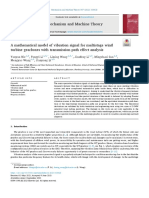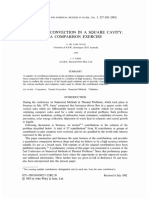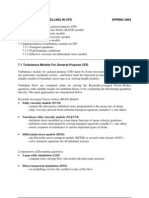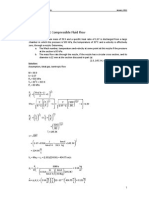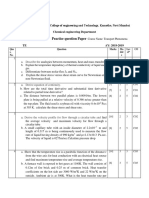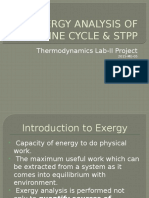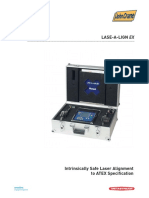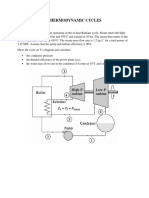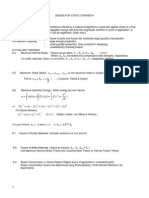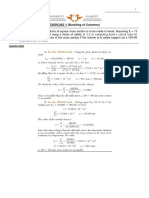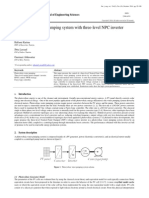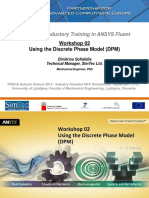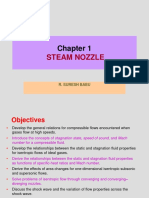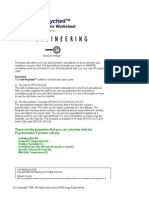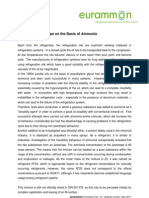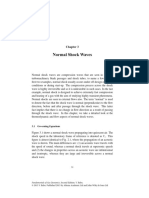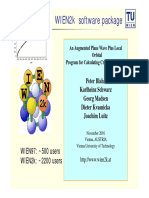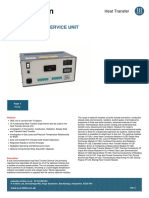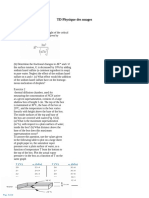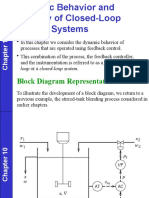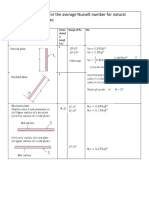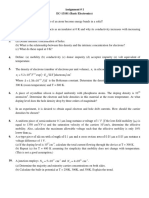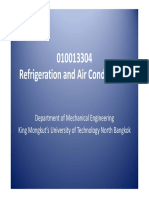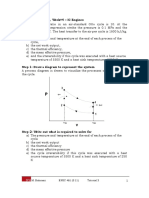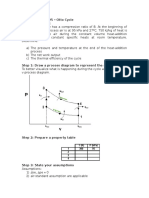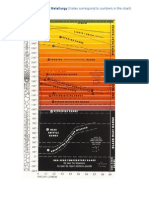ENSC 461 Tutorial, Week#4 - IC Engines
ENSC 461 Tutorial, Week#4 - IC Engines
Uploaded by
andres179Copyright:
Available Formats
ENSC 461 Tutorial, Week#4 - IC Engines
ENSC 461 Tutorial, Week#4 - IC Engines
Uploaded by
andres179Original Description:
Original Title
Copyright
Available Formats
Share this document
Did you find this document useful?
Is this content inappropriate?
Copyright:
Available Formats
ENSC 461 Tutorial, Week#4 - IC Engines
ENSC 461 Tutorial, Week#4 - IC Engines
Uploaded by
andres179Copyright:
Available Formats
ENSC 461 Tutorial, Week#4 IC Engines
The compression ratio in an air-standard Otto cycle is 10. At the
beginning of the compression stroke the pressure is 0.1 MPa and the
temperature is 15C. The heat transfer to the air per cycle is 1800 kJ/kg.
Determine:
a) The pressure and temperature at the end of each process of the
cycle,
b) the net work output,
c) the thermal efficiency,
d) the mean effective pressure,
e) and the irreversibility if this cycle was executed with a heat source
temperature of 3500 K and a heat sink temperature of 250 K
Step 1: Draw a diagram to represent the system
A process diagram is drawn to visualize the processes occurring during
the cycle.
P q in
s=c
o nst.
4
2 q out
s =c
o ns
t.
vTDC vBDC
v
Step 2: Write out what is required to solve for
a) The pressure and temperature at the end of each process of the
cycle
b) the net work output
c) the thermal efficiency
d) the mean effective pressure
e) the cycle irreversibility if this cycle was executed with a heat
source temperature of 3500 K and a heat sink temperature of 250
K
M. Bahrami ENSC 461 (S 11) Tutorial 3 1
Step 3: Property table
T [K] P [kPa] v [m3/kg]
1 288 100
2
3 v2
4 v1
Step 4: Assumptions
1) ke, pe 0
2) cold-air-standard assumption are applicable
Step 5: Solve
Part a)
P2 and T2 will be determined first. Referring to the process diagram, state
1 to 2 is an isentropic compression process. Therefore the ideal gas
relations for isentropic processes can be used. The temperature ratio of
the two states is related to the specific volume ratio through k as shown
in Eq1.
k 1
T2 v1
(Eq1)
T1 v 2
Noting that the ratio v1/v2 (equivalent to Vmax/Vmin) is the compression
ratio, r, and the value of k for air is 1.4, the temperature at state 2 can
be determined.
k 1
v
(288)10
1.4 1
T2 T1 1 723.4[ K ] T2
v2
Again, since the process from state 1 to 2 is isentropic, the ideal gas
relation relating the specific volume and pressure ratios through k can
be used as shown in Eq2.
k k
P2 v1 v
P2 P1 1 (Eq2)
P1 v 2 v2
Noting that v1/v2 is equal to the compression ratio, the pressure at state
2 can be determined as shown below.
M. Bahrami ENSC 461 (S 11) Tutorial 3 2
k
v
P2 P1 1 100[kPa]10 2511.9[kPa] P2
1.4
v2
Performing an energy balance for the constant volume heat addition
process (2 3), Eq3 is obtained.
qin u 3 u 2 (Eq3)
For an ideal gas the internal energy is a function of temperature only.
Using the assumption of constant specific heats evaluated at room
temperature, the change in internal energy can be determined using Eq4.
u 3 u 2 cv T3 T2 (Eq4)
The problem statement gives the value of qin as 1800 kJ/kg. Substituting
Eq4 into Eq3 along with the known value of qin, the temperature at state
3 can be determined.
kJ
1800
q
qin cv (T3 T2 ) T3 in T2 kg 723.4 K 3230.4[ K ]
T3
cv kJ
0.718
kg K
Since the process from 2 to 3 is executed over a constant volume, the
ideal gas law can be applied separately to both state 3 and state 2 and
combined as shown below in Eq5.
T2 R T3 R T
v2 v3 P3 P2 3 (Eq5)
P2 P3 T2
Substituting the known values into Eq5, the pressure at state 3 can be
solved for as shown below.
T 3230.4 K
P3 P2 3 (2511.9[kPa]) 11216.6[kPa] P3
T2 723.4 K
Since the process from 3 to 4 is isentropic, the temperature at state 4
can be determined using the ideal gas relation relating the temperature
and specific volume ratios through k as shown in Eq6.
M. Bahrami ENSC 461 (S 11) Tutorial 3 3
k 1
v
T4 T3 3 (Eq6)
v4
Noting that v3/v4 is the inverse of the compression ratio, the temperature
at state 4 can be determined.
1.4 1
1
T4 (3230.4[ K ]) 1286[ K ] T4
10
The pressure can be determined from the isentropic relation for an ideal
gas, which relates the pressure and the specific volume ratios through k
as shown in Eq7.
k
v
P4 P3 3 (Eq7)
v4
Noting again that v3/v4 is the inverse of the compression ratio, the
pressure at state 4 can be determined.
k
v
1.4
1
P4 P3 3 11216.6[kPa] 445.6[kPa] P4
v4 10
Part b)
An overall energy balance on the cycle can be used to find an expression
for the net work output as shown in Eq8.
qin win qout wout wnet wout win qin qout (Eq8)
The value of qin is given in the problem statement so the problem reduces
to finding the value of qout. Performing an energy balance for the process
from 4 to 1, qout can be determined from the temperature difference
between state 4 and 1 as shown in Eq9.
q out u 4 u1 cv T4 T1 (Eq9)
Substituting the known values into Eq9, qout can be determined as
shown below.
M. Bahrami ENSC 461 (S 11) Tutorial 3 4
kJ kJ
q out cv T4 T1 0.718 1286[ K ] 288[ K ] 716.6
kg K kg
Using this result with the given qin = 1800 kJ/kg and Eq8, the net work
output can be determined as shown below.
kJ kJ Answer
wnet qin q out (1800 716.6) 1083.4
kg kg (b)
Part c)
To calculate the thermal efficiency the general expression for efficiency
(benefit/cost) can be used.
th
benefit wnet 1083.4[kJ ]
60.2% Answer
cos t qin 1800[kJ ] (c)
The Otto cycle thermal efficiency can also be determined using the
equation that makes use of the compression ratio.
th ,Otto 1
1
1
1
60.2%
Answer
r k 1
10 0.4 (c)
Part d)
The mean effective pressure (MEP) can be determined using Eq10.
wnet
MEP (Eq10)
v1 v 2
The value of wnet was determined in part b) but the values v1 and v2 are
unknown. v1 can be determined by applying the ideal gas law to state 1
as shown below.
kJ
0.287 288[ K ]
RT1 kg K m3
v1 0.827
P1 100[kPa] kg
v2 is related v1 through the compression ration, r, and can be determined
as shown below.
M. Bahrami ENSC 461 (S 11) Tutorial 3 5
m3
0.827
kg 0.0827 m
3
v1 v
r v2 1
v2 r 10 kg
Substituting these results into Eq10, the value of the MEP can be
determined as shown below.
kJ
1083.4
MEP
wnet
kg 1456.4[kPa] Answer
v1 v 2 m3 (d)
0.827 0.827
kg
Part e)
The irreversibility of the cycle (exergy destroyed) if the source and sink
temperatures were 3500 K and 250 K respectively, can be determined
from application of Eq11.
x destroyed T0 s gen (Eq11)
The entropy generated during this cycle can be determined by performing
an entropy balance over each process as shown in Eq12 - 15.
Since the process from 1 to 2 is isentropic with no heat transfer and
occurs in a closed system there will be no entropy generated.
s gen,12 s sys s out sin 0 (Eq12)
Since the process from 2 to 3 occurs over constant volume with heat
transfer into the system, there will be entropy generated as shown in
Eq13.
qin
s gen, 23 s sys s out sin ( s 3 s 2 ) (Eq13)
Tsource
Since the process from 3 to 4 is isentropic with no heat transfer and
occurs in a closed system there will be no entropy generated.
s gen,34 s sys s out sin 0 (Eq14)
M. Bahrami ENSC 461 (S 11) Tutorial 3 6
Since the process from 4 to 1 occurs over constant volume with heat
transfer out of the system, there will be entropy generated as shown in
Eq15.
q out
s gen, 41 s sys s out sin ( s1 s 4 ) (Eq15)
Tsin k
The total entropy generated will be the sum of the entropy generated
during each process as shown in Eq16.
q q
s gen out in ( s1 s 4 ) ( s3 s 2 ) (Eq16)
Tsin k Tsource
Since the compression and expansion processes are modeled as
isentropic s4 = s3 and s2 = s1. Therefore Eq16 reduces to Eq17.
q q
s gen out in (Eq17)
Tsin k Tsource
The total entropy generated during the cycle is determined by
substituting all of the known parameters into Eq17 as shown below.
kJ kJ
716.6 1800
kg kg 2.352 kJ
s gen
3500[ K ] kg K
250[ ]
K
Substituting this result into Eq11, the irreversibility of cycle is
determined as shown below.
kJ kJ Answer
x destroyed T0 s gen (298[ K ]) 2.352 700.93
kg K kg (e)
Step 5: Concluding Remarks & Discussion
The pressures and temperatures at the end of each process are
summarized in the table below.
T [K] P [kPa]
1 288 100
2 723.4 2511.9
M. Bahrami ENSC 461 (S 11) Tutorial 3 7
3 3230.4 11216.6
4 1286 445.6
The net work output was found to be 1083.4 kJ/kg. The thermal
efficiency of the cycle was found to be 60.2%. The MEP was determined
to be 1456.4 kPa. The irreversibility of the cycle if the source and sink
temperatures were 3500 K and 250 K would be 700.93 kJ/kg.
M. Bahrami ENSC 461 (S 11) Tutorial 3 8
You might also like
- Numicon Firm Foundations - Counting and Number Ideas Book 1Document33 pagesNumicon Firm Foundations - Counting and Number Ideas Book 1helderNo ratings yet
- Contoh Soal Dan Penyelesain Ke2Document4 pagesContoh Soal Dan Penyelesain Ke2Siti HannaNo ratings yet
- A Mathematical Model of Vibration Signal For Multistage Wind Turbine Gearboxes With Transmission Path Effect AnalysisDocument17 pagesA Mathematical Model of Vibration Signal For Multistage Wind Turbine Gearboxes With Transmission Path Effect Analysisrahul reddy100% (1)
- Compiled E105 E111Document36 pagesCompiled E105 E111MingNo ratings yet
- Useful Formula For ME5207 - V2Document3 pagesUseful Formula For ME5207 - V2김동욱No ratings yet
- Equation of State of Ideal Gases With Cobra 4Document10 pagesEquation of State of Ideal Gases With Cobra 4DanielLugoNo ratings yet
- Natural Convection in Square Cavity: A Comparison ExerciseDocument22 pagesNatural Convection in Square Cavity: A Comparison ExercisepraphultmenonNo ratings yet
- Oriental Motor Motor Sizing CalculationsDocument10 pagesOriental Motor Motor Sizing CalculationsKha VeenNo ratings yet
- Tutorial - 6 - EntropyDocument7 pagesTutorial - 6 - EntropyanotherdeobiNo ratings yet
- (Unit Operations Laboratory-2) : Name: Siraj Ali Aldeeb ID: 3214118Document11 pages(Unit Operations Laboratory-2) : Name: Siraj Ali Aldeeb ID: 3214118Siraj AL sharifNo ratings yet
- Journal Pre-Proofs: Applied Thermal EngineeringDocument40 pagesJournal Pre-Proofs: Applied Thermal EngineeringDedi AfandiNo ratings yet
- Computational Fluid Dynamics: The Finite-Volume Method: David ApsleyDocument29 pagesComputational Fluid Dynamics: The Finite-Volume Method: David ApsleyHassan AliNo ratings yet
- T3d TutorialDocument28 pagesT3d TutoriallitosfearNo ratings yet
- Apsley-Turbulence Modelling in CFDDocument17 pagesApsley-Turbulence Modelling in CFDjuanarcos_778612No ratings yet
- Solar Chimney Final DraftDocument26 pagesSolar Chimney Final DraftKothapalli Phanindra83% (6)
- TP Turbomachine1 Pelton Wheel Lab SheetDocument7 pagesTP Turbomachine1 Pelton Wheel Lab SheetAbdelwahab.gfNo ratings yet
- Free Vibration of One Degree of Freedom Systems: Initial DeviationDocument8 pagesFree Vibration of One Degree of Freedom Systems: Initial DeviationEugine BalomagaNo ratings yet
- EX-Radial Temperature Distribution For SteadyDocument11 pagesEX-Radial Temperature Distribution For SteadyRasoul MohsenNo ratings yet
- Compressible Flow Across A Varying Area PassageDocument4 pagesCompressible Flow Across A Varying Area PassageGaurav VaibhavNo ratings yet
- Tutorial C5 AnswerDocument7 pagesTutorial C5 AnswerAustin Phua Yun HockNo ratings yet
- Me 409 Compressible Fluid Flow: Tutorial 3: Numerical Problems On One Dimensional Isentropic FlowDocument8 pagesMe 409 Compressible Fluid Flow: Tutorial 3: Numerical Problems On One Dimensional Isentropic FlowVenkitaraj K PNo ratings yet
- 5.performance of Transmission Lines-1Document36 pages5.performance of Transmission Lines-1Rume EmujekarohwoNo ratings yet
- TPDocument2 pagesTPRonit VelariNo ratings yet
- Exergy Analysis of Rankine Cycle & STPPDocument18 pagesExergy Analysis of Rankine Cycle & STPPNouman KhalidNo ratings yet
- EcodialAdvanceCalculation HelpDocument33 pagesEcodialAdvanceCalculation HelpChàng NgốcNo ratings yet
- Lase Align Ex - Laser AllignmentDocument12 pagesLase Align Ex - Laser Allignmentazayfathir100% (2)
- The Secant MethodDocument6 pagesThe Secant MethodAYU JANNATULNo ratings yet
- CRYOGENIC LAB Practical FileDocument10 pagesCRYOGENIC LAB Practical FileSantosh BaraiyaNo ratings yet
- 05 - Thermodynamic - Cycles - (Rankine) PDFDocument6 pages05 - Thermodynamic - Cycles - (Rankine) PDFAntonio Di FioreNo ratings yet
- Slides of All TurboDocument383 pagesSlides of All TurboDeivid William TorresNo ratings yet
- Homework Assignment (Viscous Flow)Document22 pagesHomework Assignment (Viscous Flow)Kevin RamosNo ratings yet
- Lecture Static FailureDocument6 pagesLecture Static FailureKelly MooneyNo ratings yet
- Experiment: 1: Vgec Chandkheda Basic Electronics (3110016)Document6 pagesExperiment: 1: Vgec Chandkheda Basic Electronics (3110016)Ridham PatelNo ratings yet
- Synchronous Machine: Construction &types TypeDocument9 pagesSynchronous Machine: Construction &types TypeProma GurNo ratings yet
- Exercise 1 - Buckling of Columns - SolutionsDocument1 pageExercise 1 - Buckling of Columns - SolutionsTumelo InnocentNo ratings yet
- Thermal #2: Heat Flux Analysis of A Composite Modular Wall Physical ProblemDocument14 pagesThermal #2: Heat Flux Analysis of A Composite Modular Wall Physical ProblemharangreatNo ratings yet
- Photovoltaic Water Pumping System With Three-Level NPC InverterDocument10 pagesPhotovoltaic Water Pumping System With Three-Level NPC InverterTI Journals PublishingNo ratings yet
- Fluent-Intro 14.5 WS02 Discrete Phase PDFDocument32 pagesFluent-Intro 14.5 WS02 Discrete Phase PDFHaider AliNo ratings yet
- Narada AG12V200Document2 pagesNarada AG12V200Roman CorralesNo ratings yet
- Chap 17 LectureDocument47 pagesChap 17 LecturesureshbabuNo ratings yet
- The Diesel Cycle: c = 1005 J/Kg K c = 718 J/kg γ = 1.4 R = 287 J/kg KDocument11 pagesThe Diesel Cycle: c = 1005 J/Kg K c = 718 J/kg γ = 1.4 R = 287 J/kg Kأحمد صلاح الدينNo ratings yet
- Get Psyched™: Psychrometric WorksheetDocument9 pagesGet Psyched™: Psychrometric Worksheetthanh_79No ratings yet
- Hydraulic Pumps: BY Abeesh Kiran A M-Tech Design and Precision Engineering Nitk Surathkal, KarnatakaDocument62 pagesHydraulic Pumps: BY Abeesh Kiran A M-Tech Design and Precision Engineering Nitk Surathkal, KarnatakaFaisal Rafique100% (1)
- Performance Evaluation of A Air Conditioner According To Different Test Standards PDFDocument9 pagesPerformance Evaluation of A Air Conditioner According To Different Test Standards PDFIAEME PublicationNo ratings yet
- R-723 - An Azeotrope On The Basis of AmmoniaDocument6 pagesR-723 - An Azeotrope On The Basis of AmmoniaevrimkNo ratings yet
- Vikash Babu Fundamentals of Gas Dynamic-45-62Document18 pagesVikash Babu Fundamentals of Gas Dynamic-45-62عمر ربيع المحلاوىNo ratings yet
- Pump and Gas Moving EquipmentDocument13 pagesPump and Gas Moving EquipmentM.Ghulam Al-AyubiNo ratings yet
- WIEN2k Getting StartedDocument58 pagesWIEN2k Getting StartedbatistaufrnNo ratings yet
- H112-Heat Transfer Service UnitDocument3 pagesH112-Heat Transfer Service UnitJuan David mosquera garciaNo ratings yet
- A Case Study On Thermodynamic Analysis of Cogeneration Power Plant (IRJET-V2I9163)Document5 pagesA Case Study On Thermodynamic Analysis of Cogeneration Power Plant (IRJET-V2I9163)luis hyungNo ratings yet
- TD Physique NuageDocument3 pagesTD Physique Nuageelsa olive ze100% (1)
- 8-Euler Equation Axial Compressors-Axial TurbinesDocument103 pages8-Euler Equation Axial Compressors-Axial TurbinesAscharya ShrivastavaNo ratings yet
- Block Diagram Representation: Loop or A Closed-Loop SystemDocument63 pagesBlock Diagram Representation: Loop or A Closed-Loop SystemaliNo ratings yet
- USFULL Solar Pump Inverter 2021 01Document4 pagesUSFULL Solar Pump Inverter 2021 01hector ayalaNo ratings yet
- Empirical Correlations For Natural ConvectionDocument2 pagesEmpirical Correlations For Natural ConvectionYash BansodNo ratings yet
- Synchronous Machines-1Document41 pagesSynchronous Machines-1Rouxcel abutoNo ratings yet
- Assignment 1 Basic ElectronicsDocument1 pageAssignment 1 Basic ElectronicsAayushNo ratings yet
- Refrigeration and Air ConditioningDocument25 pagesRefrigeration and Air ConditioningVitthawat STNo ratings yet
- Experiment No.2: Operation of D.C Motors, Running and ReversingDocument10 pagesExperiment No.2: Operation of D.C Motors, Running and Reversingwrya hussainNo ratings yet
- ENSC 461 Tutorial, Week#4 - IC EnginesDocument13 pagesENSC 461 Tutorial, Week#4 - IC EnginesIgnacio Garcia FerrerNo ratings yet
- Tutorial 5Document5 pagesTutorial 5Bob ChinNo ratings yet
- Tutorial 5Document5 pagesTutorial 5RAJANo ratings yet
- Class - 6 - Bar Graph - T - 8 - 3 PDFDocument6 pagesClass - 6 - Bar Graph - T - 8 - 3 PDFParul GuptaNo ratings yet
- Pictorial Guide To Basic Metallurgy (Notes Correspond To Numbers in The Chart)Document2 pagesPictorial Guide To Basic Metallurgy (Notes Correspond To Numbers in The Chart)shaikz_1No ratings yet
- What Are Some Things You Know About Acids and Bases?: Think in INK!Document2 pagesWhat Are Some Things You Know About Acids and Bases?: Think in INK!LamiyaNo ratings yet
- COS1512 Tutorial 103 2016Document8 pagesCOS1512 Tutorial 103 2016Lina Slabbert-van Der WaltNo ratings yet
- Science 8 Summative Test 1 Q1Document3 pagesScience 8 Summative Test 1 Q1Claudine BuanNo ratings yet
- 3 EthanolDocument14 pages3 EthanolVISHAL PATELNo ratings yet
- Mobile Portable PrintersDocument2 pagesMobile Portable PrintersAnonymous WD109UakyNo ratings yet
- Winche Modelo ARS 403Document1 pageWinche Modelo ARS 403neilNo ratings yet
- A Interphasechangefoam Tutorial: CFD With Opensource SoftwareDocument18 pagesA Interphasechangefoam Tutorial: CFD With Opensource Softwarerohit14octNo ratings yet
- AP Shah Blockchain Imp NotesDocument71 pagesAP Shah Blockchain Imp NotesdhansemuazNo ratings yet
- TCS NQT Online Test Pattern: Section Order Section # Qs Duration (Minutes)Document33 pagesTCS NQT Online Test Pattern: Section Order Section # Qs Duration (Minutes)SAURABH SRIVASTAVNo ratings yet
- Basic Detection Techniques Quasi-Optical TechniquesDocument39 pagesBasic Detection Techniques Quasi-Optical TechniquesArni SopiantiNo ratings yet
- Sick EncoderDocument6 pagesSick EncoderUsman KhanNo ratings yet
- Line RuptersDocument17 pagesLine RuptersjuevesNo ratings yet
- Alkenes 1 QPDocument11 pagesAlkenes 1 QPasddf asdafNo ratings yet
- Clinimetric Evaluation of Active Range of Motion Measures in Patients With Non-Specific Neck Pain: A Systematic ReviewDocument10 pagesClinimetric Evaluation of Active Range of Motion Measures in Patients With Non-Specific Neck Pain: A Systematic ReviewMonikaNo ratings yet
- Chapter-4A (Transforming Data Into Information)Document38 pagesChapter-4A (Transforming Data Into Information)api-3774277No ratings yet
- Handplane Tune UpDocument6 pagesHandplane Tune UpAndrew Catlin100% (5)
- 255DSDocument2 pages255DSAlberto Moreno GarrigaNo ratings yet
- 130787-1 - FabWorld Op ERCDocument52 pages130787-1 - FabWorld Op ERCSalvador BarrónNo ratings yet
- Final ProjectDocument8 pagesFinal Projectalya batrisyiaNo ratings yet
- MathsModuleVol IIDocument231 pagesMathsModuleVol IIkritagyasharma29No ratings yet
- Buku Standarisasi Spek Mtu PLN - SK Dir 216 (Bus VT)Document1 pageBuku Standarisasi Spek Mtu PLN - SK Dir 216 (Bus VT)PontasNo ratings yet
- The Earth's Magnetic Field: Stephen Kimbrough Damjan Štrus Corina TomaDocument5 pagesThe Earth's Magnetic Field: Stephen Kimbrough Damjan Štrus Corina TomaDavidNo ratings yet
- Grade 12 ASSIGNMENTDocument8 pagesGrade 12 ASSIGNMENTupmzamoNo ratings yet
- EPA's Non-CBI Summary Tables For 2015 Company Progress Reports (Final Progress Reports)Document4 pagesEPA's Non-CBI Summary Tables For 2015 Company Progress Reports (Final Progress Reports)Benouna FertNo ratings yet
- AD01 Q 11 To Q 30Document17 pagesAD01 Q 11 To Q 30Kishore NNo ratings yet
- Computational Fluid Dynamics Course Information: by Dr. A. Nurye Faculty of Mechanical Engineering Nurye@ump - Edu.myDocument8 pagesComputational Fluid Dynamics Course Information: by Dr. A. Nurye Faculty of Mechanical Engineering Nurye@ump - Edu.myeldrainyNo ratings yet


